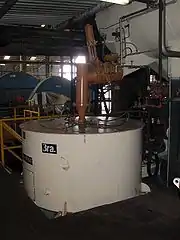Sugar refinery
A sugar refinery is a refinery which processes raw sugar from cane or beets into white refined sugar.



Many cane sugar mills produce raw sugar, which is sugar that still contains molasses, giving it more colour (and impurities) than the white sugar which is normally consumed in households and used as an ingredient in soft drinks and foods. While cane sugar does not need refining to be palatable, sugar from sugar beet is almost always refined to remove the strong, usually unwanted, taste of beets from it.[1] The refined sugar produced is more than 99 percent pure sucrose.
Many sugar mills only operate during the harvest season, whereas refineries may work the year round. Sugar beet refineries tend to have shorter periods when they process beet than cane refineries, but may store intermediate product and process it in the off-season. Raw sugar is either processed and sold locally, or is exported and refined elsewhere.
Sugar refineries date back to Arab Egypt in the 12th century.[2] An artisanal version is the trapiche, later substituted by the engenho or ingenio.
Sugar refineries are often located in heavy sugar-consuming regions such as North America, Europe, and Japan. Since the 1990s, many state-of-the art sugar refineries have been built in the Middle East and North Africa region, e.g. in Dubai, Saudi Arabia and Algeria. The world´s largest sugar refinery company is American Sugar Refining with facilities in North America and Europe.
Raw sugar processing
Affination

The raw sugar is stored in large warehouses and then transported into the sugar refinery by means of transport belts. In the traditional refining process, the raw sugar is first mixed with heavy syrup and centrifuged to wash away the outer coating of the raw sugar crystals, which is less pure than the crystal interior. Many sugar refineries today buy high pol sugar and can do without the affination process.
Screening
The remaining sugar is then dissolved to make a syrup (about 70 percent by weight solids), which is clarified by the addition of phosphoric acid and calcium hydroxide that combine to precipitate calcium phosphate. The calcium phosphate particles entrap some impurities and absorb others, and then float to the top of the tank, where they are skimmed off.
After any remaining solids are filtered out, the clarified syrup is decolorized by filtration through the use of bone char, which is made from the bones of cattle,[3] a bed of activated carbon or, in more modern plants, ion-exchange resin.
Sugar house


The purified syrup is then concentrated to supersaturation and repeatedly crystallized under vacuum to produce white refined sugar. As in a sugar mill, the sugar crystals are separated from the mother liquor by centrifuging. To produce granulated sugar, in which the individual sugar grains do not clump together, sugar must be dried.
Sugar drying and storage
Drying is accomplished first by drying the sugar in a hot rotary dryer, and then by blowing cool air through it for several days in conditioning silos. The finished product is stored in large concrete or steel silos. It is shipped in bulk, big bags or 25 – 50 kg bags to industrial customers or packed in consumer-size packages to retailers.
The dried sugar must be handled with caution, as sugar dust explosions are possible. For example, a sugar dust explosion which led to 13 fatalities was the 2008 Georgia sugar refinery explosion in Port Wentworth, GA.
Factory automation in sugar refineries
As in many other industries factory automation has been promoted heavily in sugar refineries in recent decades. The production process is generally controlled by a central process control system, which directly controls most of the machines and components. Only for certain special machines such as the centrifuges in the sugar house decentralized PLCs are used for security reasons.[4]
References
- Mitchell, Donald O. (2004). Sugar Policies: Opportunity for Change. World Bank Publications. p. 10.
- Satō, Tsugitaka (1997). State and Rural Society in Medieval Islam: Sultans, Muqtaʻs, and Fallahun. BRILL. pp. 119, 211, 215. ISBN 9789004106499.
- "Are animal ingredients included in white sugar?".
- "article on centrifugal controls, retrieved on April 23, 2011". Bma-de.com. Retrieved 2013-07-12.
Bibliography
- Onses, Richard (1987). Continuous dissolution process for sugar, in Alimentacion Equipos y Tecnologio, Editorial Alcion, May 1987. Barcelona.
External links
| Wikimedia Commons has media related to Sugar factories. |
